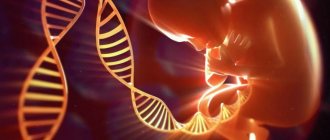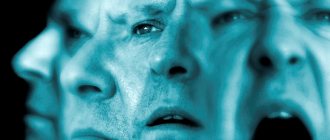Medical information is reliable Checked by Shaidullin Renat Flyurovich
Schizoaffective disorder is an endogenous mental disorder, the symptoms of which simultaneously resemble the symptoms of both schizophrenia and affective psychoses. It is characterized by impaired thinking and unregulated emotions. May include disorganization of speech, hallucinations, and paranoid delusions. The diagnosis of the disease is made based on observation if a person has simultaneously signs of bipolar disorder, depression and schizophrenia, but there are no clear criteria for each of these deviations. The pathology usually manifests itself at a young age and is treated by a psychiatrist.
Causes of schizoaffective disorder
The exact causes of the pathology are unknown, like many other mental disorders, but there are several individual characteristics of the body that increase the likelihood of developing schizoaffective disorder. Most often it is observed in individuals with a hereditary predisposition.
Researchers have identified a risk gene that causes the development of schizophrenia. But under certain conditions, it is in a “dormant state” and begins to manifest itself after exposure to severe stress, severe somatic illness, etc. In addition, the appearance of this gene in the fetus may be due to mutational processes. There is also an assumption of the etiological and pathogenetic similarity of this disease and epilepsy, since in both cases there is a periodicity of manifestations and characteristic changes in the electrical activity of the brain on the EEG.
Provoking factors for the development of schizoaffective disorder can be:
- low social status;
- hunger and poverty;
- hostilities;
- forced migration;
- complete loneliness and lack of help from other people;
- alcohol and drug use.
In the case of the use of psychoactive drugs and alcohol, the possibility of developing this mental disorder increases. At the same time, people with this pathology also often have chemical dependencies, with the help of which they try to get away from their painful sensations, but this only aggravates the process of degradation. To determine what is primary – a mental illness or an addiction to alcohol or drugs, an experienced specialist and monitoring of the patient’s condition in a psychiatric hospital are required.
Dr. Isaev’s clinic has all the conditions for conducting differential diagnosis and providing professional assistance for schizoaffective disorder. For more detailed information, you just need to call the number listed on the website.
Glossary of terms
In this section we have collected all the terms that you might encounter in this article. Gradually, we will collect from these explanations a real dictionary of a narcologist-psychiatrist. If some concepts remain unclear to you, leave your comments under the articles on our site. We will definitely help you figure it out.
Personality accentuation
- a personality trait in which some character traits are strengthened, while others are, on the contrary, dull. Such patients exhibit selective vulnerability to the manifestations of some psychogenic influences and amazing resistance to the manifestations of others.
Alcohol delirium
– alcoholic psychosis associated with alcohol abuse.
Occurs in the second or third stage of alcoholism, when withdrawing from alcohol (cessation of consumption). Alcoholic delirium is accompanied by hallucinations (auditory, tactile and visual), as well as chills and fever. In most cases, hallucinations seem threatening to the patient; many note that they saw devils, insects and other dangerous creatures. The greatest danger is the risk of -harm
(damage to oneself), sometimes leading to death. As a rule, delirium tremens develops between the second and fifth days after an abrupt cessation of binge drinking.
Affective disorder
– a mental disorder that is associated with disturbances of affect (the balance between internal mood and its external manifestations). In other words, an affective disorder is a disorder that is based on a disturbance in the emotional state.
Delirium (delusional syndrome)
– a mental disorder that is characterized by erroneous, completely uncontrollable judgments in the patient. These judgments are capable of being formed without any explanation, reason or appropriate conditions for this. This syndrome manifests itself in patients with schizophrenia, as well as in people suffering from diseases of the central nervous system of a vascular and atrophic nature. In addition, patients diagnosed with psychosis are also susceptible to the development of delusional syndrome.
Hallucination
- an image that appears in the patient’s mind without external conditions. As a rule, hallucinations appear with the use of psychoactive substances (alcohol, drugs, many psychotropic medications), significant fatigue, as well as with mental disorders and neuralgia. Regular and prolonged hallucinations are a common occurrence in schizophrenia and are significant complications of its clinical picture.
Depressed state (depression)
– a long-term mental disorder, accompanied by deterioration in mood, loss of the ability to rejoice, disruptions in thinking, and obvious motor retardation.
Hysterical psychosis
– a type of psychosis associated with hysterical personality disorder, which is characterized by superficial thinking, the need for the attention of others, pretentious behavior, as well as suggestibility and self-hypnosis.
Pseudo-dementia
is a dementia-like condition, distinguished by the fact that it is caused by depression and is reversible. A person in a state of pseudodementia appears confused, has sleep disturbances, memory loss and other cognitive problems, and begins to talk. However, research shows that in reality everything is fine with memory, speech, and coordination of movements.
Puerilism
– a form of reactive psychosis, a defensive reaction of the psyche to significant nervous shock or mental trauma.
Selfharm (self-harm)
– deliberate damage to one’s body for internal reasons, without the intention of dying. Selfharm is considered a symptom of many mental disorders. Typically, self-harm involves cutting the skin, scratching oneself, burning the skin, pinching limbs, picking wounds, pulling out hair, and so on.
Twilight stupefaction (twilight deviation)
- a deviation of consciousness that appears suddenly and is characterized by a serious inability to navigate in the surrounding space. At the same time, the patient retains the ability to perform his usual automated actions. As a rule, twilight deviation arises and ends suddenly and does not last long (such mental disorders are called “fleeting” or “transient”.
Types of Schizoaffective Disorder
Depending on the predominance of a particular clinical picture, the following types of shazoaffective disorder are distinguished:
- manic;
- depressive;
- mixed;
- unknown etiology;
- other types of deviation.
The manic type is difficult, and the prognosis is often unfavorable. Such a person poses a danger during an exacerbation period and requires placement in a psychiatric ward. The depressive form of the disorder resembles prolonged or moderate clinical depression. In the mixed type, signs of schizophrenia and a picture of affective disorders are noted. Symptoms of schizoaffective disorder begin with the pre-manifest stage, then the attack itself is observed, and after that a remission of varying duration occurs. On average, the acute period lasts for 6-8 months.
Any form of schizoaffective disorder requires timely help. If such a problem has arisen in your family, call us and an experienced specialist will tell you what can be done in this case.
General understanding of schizophrenia
Schizophrenia is a mental illness that can have severe forms and is characterized by disorders of the emotional area of a person: disturbances in thought processes, perception, behavior, inability to communicate in society. Most often, schizophrenic symptoms manifest themselves in the age period from 14 to 35 years.
The presence of schizophrenia leads to significant disabilities: the patient does not have the opportunity to receive an education or fully engage in work. It is important to note that this disease cannot be completely cured. However, the severity of its course can be controlled by a psychiatrist. By prescribing the necessary medications in a timely manner, using psychosocial support, the doctor has the opportunity to stop or minimize the manifestation of symptoms.
Symptoms
Diagnosing schizophrenia, especially at an early stage, can be very difficult. This is due to the fact that many of the signs that characterize this disease may indicate other mental disorders. In this case, the doctor sets a period of observation of the patient, during which he conducts a full diagnosis of his condition.
The main symptoms that may indicate the presence of such a pathology are the following:
- auditory, visual or tactile hallucinations appear. The patient begins to see, hear, feel what is not happening in reality;
- delusional states - the patient builds false beliefs for himself that are not shared by others. At the same time, schizophrenics are almost always very suspicious and distrustful of people;
- behavior takes on the features of inappropriate - the patient is disorganized, may forget about the rules of hygiene, appearance, and normal physical sensations are dulled. This may be accompanied by aimless walking, muttering, etc. The mood may change dramatically;
- speech becomes slurred and incoherent. A schizophrenic often independently invents his own words (sentences), giving them a special meaning that is understandable to him alone;
- emotional disturbances are clearly noticeable - apathy, indifference to what is happening, facial expressions, gestures may be absent or, conversely, become too active;
- a person creates his own inner world, withdraws into himself, and practically does not communicate with others.
Diagnostics
Correct, competent diagnosis of mental illness is the beginning of the path to its successful treatment. Due to the fact that it is extremely difficult to determine schizophrenia, especially at the first stage of its development, specialists are as consistent and attentive as possible at this stage.
The doctor regularly communicates with the patient, monitors the dynamics of the development of symptoms, their modification, etc. In addition, the following clinical studies are carried out:
- the patient’s immune status is determined;
- a general and biochemical blood test is performed;
- a hormonal profile is formed;
- additional tests are prescribed to rule out organic brain diseases;
- a general therapeutic and neurological examination is carried out;
- a rapid test is being compiled to determine schizophrenia.
In psychiatric practice, special diagnostic criteria are also known. The presence of at least one of them, and observation of it for 30 days, provides grounds for a more in-depth diagnosis of the disease. Among these criteria are:
- the presence of hallucinations (visions);
- delusions of perception (erroneous judgments about something, paranoia);
- echo of thoughts (voices in the patient’s head);
- associativity (a person avoids communication).
Causes of the disease, its prevention and treatment
Studies of schizophrenia as a mental illness have not found a single factor that could provoke its occurrence. Scientists have come to the conclusion that this mental disorder can occur when the body is exposed to various factors: genetic predisposition, psychosocial circumstances, physical and psychological exhaustion of a person, etc.
Preventive methods to prevent the occurrence of schizophrenia are especially necessary if a person has “blood” relatives with this disease. Prevention consists of regular counseling, testing and, if necessary, supportive care.
Treatment for schizophrenia can be outpatient or inpatient. The second treatment option is necessary in case of acute attacks of the disease, frequent and prolonged relapses. Patients, depending on the severity of the disease, are prescribed antipsychotic drugs of different categories. They are determined exclusively by a specialist after examining the patient.
Schizoaffective disorder: symptoms
The first symptoms of this mental disorder are usually observed in adults; children, as a rule, do not suffer from it; the pathology is more often described in women. The first attacks, reminiscent of schizophrenia, alternate with affective manifestations and delusions, while relatively preserved social adaptation and ability to work are observed. Sometimes, at first, emotional disturbances come first, which are replaced by delusions and hallucinations. In some cases, deviations occur simultaneously, and then diagnosis does not cause difficulties.
Schizoaffective disorder refers to transient conditions of an endogenous nature. In this case, disturbances of the emotional type prevail over productive symptoms. The attack is characterized by significant polymorphism of manifestations; its structure includes depressive-paranoid and manic-paranoid types of attack.
The main symptom accompanying schizoaffective disorder is frequent changes in the patient's mood. This happens suddenly, unpredictably and cannot be controlled. After that, attention deficit disorder, hallucinations, and a person’s ability to control their behavior are added to the overall picture. He ceases to understand the difference between reality and his own far-fetched illusions; imagination begins to play the leading role. The disease can manifest itself as pronounced deviations that become noticeable to everyone around, or it can occur in an erased form, when the changes are visible only to those close to you. Typically, schizoaffective disorder is accompanied by the following symptoms:
- depression;
- depression;
- loss of appetite;
- change in body weight;
- addiction to drinking alcohol;
- disturbance of the alternation of sleep and wakefulness;
- lack of interest in what is happening around;
- weakness, loss of strength;
- self-flagellation, decreased self-esteem;
- decreased concentration;
- lack of control over thoughts and actions;
- inadequate emotional reaction;
- suicidal tendencies, thoughts of death;
- strange behavior.
A person with schizoaffective disorder suffers from hallucinations, stops performing simple hygiene procedures, and develops obsessive ideas. The acceleration of thought processes leads to the fact that speech becomes fast, words seem to be layered on top of each other, endings are swallowed.
When the first signs of schizoaffective disorder appear in a loved one, you should not expect the problem to solve itself. The sooner you seek help, the more effective the therapy will be.
In depressive-paranoid types of attacks, the pathology manifests itself in the form of decreased mood and delusions of self-deprecation, ideas of poisoning, destruction, the presence of a fatal incurable disease, and sinfulness. A person suffers from apathy, depression, insomnia. A severe form of the seizure is manifested by depressive oneiroid or stupor. Depressive attacks, if left untreated, can result in the development of addiction or attempted suicide.
The manic form of the attack is accompanied by a decreased need for sleep, unbridled joy, agitation that does not correspond to the situation, and ideas of one’s own importance and greatness. With severe psychosis, delusions of fantastic content and other productive schizophrenia-like symptoms appear. There is a decrease in concentration, increased energy, and inappropriate social behavior due to disinhibition of the nervous system. Clinical manifestations do not appear immediately, but gradually increase in intensity. Sometimes there are ideas of persecution and pronounced aggressiveness, in which a person begins to pose a danger to those around him.
Mixed states represent frequent fluctuations from hypomania and mania to depression. These affects are accompanied by delusions, which contain the theme of the struggle between good and evil with auditory hallucinations of a positive and negative type. They are contradictory and often mutually exclusive in meaning. The mixed type of schizoaffective disorder manifests itself in the form of alternating depressive-paranoid and manic-paranoid disorders (happiness-fear psychosis).
During the period of remission, a person does not have an emotional-volitional defect; after an acute attack, residual symptoms of schizophrenia or affective deviations persist for some time.
Symptoms and signs of schizoaffective psychosis
Symptoms of the disease are varied and usually consist of sudden mood swings, hallucinations, and absent-mindedness. Symptoms can be pronounced or quite mild.
There are three forms of manifestation of the disease:
- In the first case, the symptoms of the disease appear when the mood is high. The patient can express thoughts about greatness, superpowers against the backdrop of fuss or fun.
- The second type is depressive in nature. Here, hypochondriacal ideas, thoughts of self-destruction, feelings of guilt, and so on are added to the lack of mood.
- The third, mixed, type is characterized by a change in mood from a feeling of universal happiness to sadness and complete apathy.
Signs of affective disorders
Clinical symptoms of schizoaffective disorder include mood disturbances and schizophrenic features. The degree of their expression is approximately the same, while they alternate or are observed simultaneously. Deviations of an emotional nature are:
- manic;
- depressed;
- agitated.
During mania, a person feels a surge of energy and strength, is always in a great mood, even to the point of euphoria, and is constantly busy doing something. His thinking speeds up greatly and he has difficulty trying to concentrate on a specific job, and problems with concentration arise. His speech becomes fast and incomprehensible due to constant jumping from one topic to another. The patient feels able to “move mountains.”
One of the variants of mania is increased irritability and anger. The person becomes aggressive, behaves rudely with other people, is rude, interrupts, and counteracts. Often this state accompanies the delirium of saving humanity from an alien invasion or another fictitious global problem of the world level.
When depressed, the patient loses his appetite, and sometimes he does not even have the strength to get out of bed. The pace of thinking processes slows down, a person feels melancholy and engages in self-flagellation, and does not find any sources of joy in life. If help is not provided in time, then during this period the likelihood of suicide greatly increases. A subtype of depression is considered to be agitation, when the patient’s sharply depressed mood is masked by active and unproductive activity, which is chaotic in nature.
Experts' forecasts
The main difference between schizophrenia and recurrent schizophrenia is the consequences of recovery from psychosis. In the second case, subject to timely and correct treatment, the patient does not experience a residual schizophrenic defect after an exacerbation. This means that his behavior will lack such manifestations as passivity, apathy, loss of social connections, irreversible emotional flattening (lack of reaction to what is happening).
As a rule, after therapy, the patient may be left with short-term and insignificant phenomena, such as increased fatigue, a feeling of inadequacy, etc. After a short time, they disappear, and the person has the opportunity to return to his previous life.
Despite the favorable prognosis, this does not make this disease easier or less significant. It is strictly contraindicated to refuse treatment or do it yourself. After a course of therapy, the patient must follow the doctor's instructions. At the same time, the patient is prescribed not only drugs that relieve and prevent possible recurrences of schizophrenic symptoms. During this period, the patient also needs to take mood-stabilizing medications.
Signs of schizophrenia
Typical signs of schizophrenia in schizoaffective disorder include:
- delusional ideas;
- hallucinations.
The patient's delirium usually corresponds to his mood. With depression, ideas of one's own worthlessness and uselessness arise. Sometimes hatred appears towards family and friends, as well as towards humanity as a whole. If mania develops, the patient insists on his greatness, considers himself perfect, is confident in his own superpowers, and points to the mission entrusted to him to save the world.
Hallucinations in schizoaffective disorder are usually auditory, but can also be visual or tactile. During an exacerbation, a person sees something that is not really there or hears non-existent voices and sounds. The situation is greatly complicated by concomitant catatonia, usually in the form of stupor.
Differential diagnosis of schizoaffective disorder
Since schizoaffective disorder includes symptoms of schizophrenia and manic-depressive psychosis, it is important to distinguish between these diseases. Schizophrenia is a severe chronic mental illness in which remission is difficult to achieve and complete recovery is impossible. It differs from schizoaffective disorder in the absence of a residual defect in the period after an exacerbation. In this case, we mean passivity, apathy, desocialization, flattening of emotions.
The bipolar state is accompanied by mood swings, but does not lead to a decrease in socialization. Its similarities with schizoaffective disorder include the following symptoms:
- episodic manifestation;
- being in a depressed or highly excited state;
- severe anxiety.
The difference is that with schizoaffective disorder, productive symptoms are present simultaneously with affective deviations. Therefore, it is impossible to immediately diagnose this pathology even with knowledge and experience. This is especially difficult if the disease does not immediately develop with signs of schizophrenia and affect during the next exacerbation. It is possible to verify the presence of the disease only after some time, and this requires constant medical supervision.
Symptoms of schizophrenia
Schizophrenia is a polymorphic disease. This means that it has many manifestations, which depend on the form of its occurrence. Conventionally, the symptoms of all psychopathologies of the schizophrenia spectrum are divided into two groups - negative and positive.
The former partially overlap with depressive symptoms of schizoaffective and affective disorders. We are talking about apathy, lack of will, lack of initiative, inability to receive pleasure, etc. Also in this state, a person is very withdrawn, tends to loneliness and idleness. All these symptoms indicate the passivity of the mental apparatus.
With an exacerbation of schizophrenia, that is, the beginning of an attack, the symptoms change. She becomes productive because her psyche shows activity. At the physiological level, there is a large release of the hormone dopamine. The patient may be very active and mobile. Thinking speeds up and begins to malfunction. In the active phase, hallucinations, delusions and catatonic disorders develop.
Hallucinations do not occur in every form of schizophrenia. They are not always present in schizoaffective psychosis.
Based on the dominant symptom, schizophrenia is divided into several types:
- Paranoid. With this form, there is always delusion - persecution, jealousy, delusions of grandeur, invention, reformism, etc. Delusions become more complex in the presence of hallucinations.
- Hebephrenic. It occurs very early, in adolescence, and is characterized by ridiculous, childish and inappropriate behavior, when, for example, the patient walks down the street naked, etc.
- Catatonic. The main symptom is movement disorders, manifested in periods of excitement and stupor. The patient may suddenly freeze in an unnatural position for several hours or even years.
- Residual. It is characterized by mild symptoms. Partially similar to depressive disorder, but it occurs after an attack, and therefore can again go into the exacerbation phase.
There are other types of schizophrenia. Thus, fur coat is characterized by the presence of attacks and remissions. This is observed in all forms of schizophrenic diseases, but in this case, each exacerbation is more complex than the previous one.
There is also sluggish schizophrenia, which can progress over years, accompanied by negative symptoms. It is quite difficult to identify it, and to differentiate it from other mental disorders is even more difficult. In other words, this disease is extremely unpredictable, and competent diagnosis can reduce the unpredictability.
Schizoaffective disorder: drug treatment
Therapy for schizoaffective disorder at Dr. Isaev’s clinic includes the use of medications to relieve symptoms and psychotherapy. If the patient shows severe aggression during an attack, he is hospitalized until a stable condition is achieved. Taking medications is the main form of assistance for this disease, while working with a psychologist is considered no less important, but auxiliary.
To treat and eliminate negative symptoms, the following are usually prescribed:
- antipsychotics, they eliminate delusions, hallucinations and other symptoms of psychosis;
- anxiolytics for sleep disturbances and severe anxiety;
- antidepressants, which stop low mood, apathy, a feeling of uselessness, the desire for one’s own death, encourage action;
- mood stabilizers to normalize mood in case of low mood or manic disorder;
- sleeping pills that help normalize a good night's rest.
Acute psychosis with this deviation is usually treated with a combination of two or more medications. But it is best for the doctor to select a dose with constant observation, and therefore the person needs to stay in the hospital for some time. After achieving remission, the patient begins outpatient treatment with periodic visits to a psychiatrist. He comes to see him or a specialist is called to his home for a routine inspection.
In our clinic, only proven, certified drugs are used to treat schizoaffective disorder. They give the desired result and at the same time have minimal side effects.
If a person has schizoaffective disorder and dependence on alcohol and psychotropic drugs, then in this case a narcologist is involved in the therapy process, since chemical addictions greatly aggravate the condition and reduce the effectiveness of treatment.
Treatment
Similar techniques are used in the treatment of schizophrenia and schizoaffective psychosis. In case of depression, development of a negative phase or depressive disorder, antidepressants help. Increased agitation, mania, and the active period of the disease are treated with the help of antipsychotics that affect neurotransmitters.
Psychotherapeutic sessions are of great importance. They are conducted individually and in groups. The patient’s relatives are also consulted, who should familiarize themselves with the basic rules of communication with people suffering from mental illness.
This does not mean that one wrong word can throw a person off balance and he will become violent. Relatives should determine by the patient’s condition, by his behavior and words, that something is wrong with him. Usually, before an exacerbation, certain symptoms intensify. If they are ignored, then even a minor event can lead to an attack. But if you take action in time, it becomes possible to stop the symptoms at an early stage.
Application of psychotherapy
Psychotherapy for patients with such a diagnosis is an auxiliary method of providing assistance; it accelerates the effect that can be achieved by precise selection of medications, consolidates the result, prolongs remission, and adapts the person to a society of healthy people. Talk therapy is often used for schizoaffective disorder. It allows you to better understand your condition, understand your own feelings and reduce their influence, identify negative attitudes that provoke destructive behavior, and replace them with constructive thoughts and actions. For this purpose, cognitive-behavioral techniques are used for individual lessons and work in groups. If the cause of the disease is psychotrauma at a young age, psychodynamic therapy is used.
If the patient is unable to express all his problems, art therapy is of great help. Taking part in art, music, or dance can help you express yourself and cope with current triggers for your attacks. Family therapy plays a leading role in the treatment of schizoaffective disorder, which allows one to influence the home environment. Thanks to the participation of loved ones in the treatment process, they can understand:
- the feelings that the patient experiences;
- what actions on their part help or hinder recovery;
- what needs to be done to make positive changes.
Many relatives behave incorrectly towards a mentally ill person. With their hypertrophied care, they cause or strengthen his feeling of inferiority. Understanding his problem, but at the same time constantly recognizing himself as weak and incompetent, the patient only aggravates his difficult situation. Thanks to family psychotherapy, a person understands how his condition and signs of the disease can affect those who live nearby. After treatment, all family members begin to act together, directing their efforts to eliminate existing difficulties and problems, and work on a strategy to prevent the next exacerbation of the pathology.
A person who has been diagnosed with schizoaffective disorder, if he contacts Dr. Isaev’s clinic in a timely manner, has the opportunity to completely get rid of the manifestations of the disease. Qualified specialists help a person with this diagnosis reduce the number of attacks and increase the time of remission for a long time.
Psychotherapeutic techniques aim to remove not only causative factors, but also reduce the likelihood of stressful effects. Work with a specialist begins after the acute attack has stopped, otherwise the doctor will not be able to achieve full contact and awareness of the problem. In general, the prognosis for this disease is favorable, but the outcome depends on the timeliness of the start of treatment and the characteristics of affective and schizophrenic manifestations.
The use of psychotherapy significantly increases the effectiveness of drug treatment. The specialist’s job is to detect hidden factors that provoke attacks, eliminate them or reduce their impact. A person is aware of the reasons for the development of deviations and understands their destructiveness. Family psychotherapy also plays a significant role, thanks to which mutual understanding between the patient and close relatives improves.
There is still no consensus on the significance of psychogenic factors in the course and clinical manifestation of schizophrenia spectrum disorders. Since the time of E. Kraepelin (1898), this problem has occupied many researchers [2-7, 9, 12, 14, 16, 17].
A variety of, often completely opposite, opinions have been expressed - from recognizing the direct etiological role of emotional stress in the development of schizophrenia [13, 15, 19] to completely denying any connection between mental trauma and this disease [8, 18]. And currently there is a large number of works devoted to the relationship and mutual influence of schizophrenia spectrum disorders and psychogenic disorders, with sometimes mutually exclusive conclusions. It should be noted that when studying disorders of the schizophrenic range in comparison with various types of psychogenic disorders in modern literature, there is practically no mention of schizoaffective disorder. This is due to the fact that schizoaffective disorder was relatively recently identified as a separate category in ICD-10.
The purpose of this study was to determine the main clinical characteristics of schizoaffective attacks that developed after emotional stress. It is a continuation of the work that we published earlier [1].
Material and methods
The studied sample was formed on the basis of a statement at the time of examination of clinical signs of schizoaffective disorder and anamnestic information about the presence of one or more intense mental traumas immediately before the onset of psychosis or at its onset.
In the main group of patients there were 57 women and 17 men aged 27-60 years (21.6% of patients were aged from 49 to 60 years). The disease most often began at the age of 21-40 years.
In accordance with ICD-10, of the 74 patients in the main group, 62.2% were diagnosed with the depressive type of schizoaffective psychosis (F25.1), 25.7% with the manic type (F25.0) and 12.1% with the mixed type (F25.2).
The comparison group included 51 patients (42 women and 9 men) with schizoaffective psychosis that arose autochthonously. Of these, 35.3% were diagnosed with the depressive type of schizoaffective disorder (F25.1), 45.1% with the manic type (F25.0), and 19.6% with the mixed type (F25.2).
Clinical-psychopathological, follow-up and experimental psychological research methods were used.
Statistical processing of data was carried out by comparing average and relative values using the χ2 test and Fisher's exact test.
Results and discussion
It is known that schizoaffective disorder occupies an intermediate position between schizophrenia and bipolar affective disorder, combining in varying proportions the clinical manifestations of both one and the other diseases. In accordance with this, schizodominant and affect-dominant variants are distinguished [10]. The noted features are manifested by polymorphism of the clinical picture, variability of symptoms, and the predominance of various psychopathological formations in the same patient during different periods of development of a schizoaffective attack.
Schizoaffective disorder with previous emotional stress is an even more complex psychopathological formation, since, along with typical endogenous mechanisms, psychogenic factors are involved in the formation of an affective-delusional psychotic state. The already variable and heterogeneous psychopathological structure of the picture of schizoaffective psychosis reflects the pathoplastic and pathokinetic influence of emotional stress. The psychogenic “refraction” of the manifestations of such psychosis often leads to diagnostic difficulties. For example, the presence of hysterical symptoms, the “sounding” of the plot of mental trauma in psychotic experiences, and “psychologically understandable” ideas of self-blame suggest the acquired, psychogenic nature of the psychosis being studied. At the same time, the presence of schizophrenia spectrum disorders (Kandinsky-Clerambault syndrome, acute sensory delusions of staging, intermetamorphosis, etc.) leaves no doubt about the endogenous origin of the psychotic state. Only a comprehensive analysis of the structure and development of schizoaffective psychosis with previous emotional stress, as well as the period preceding its manifestation, helps to resolve diagnostic difficulties, making it possible to establish certain patterns of pathodynamic relationships between endogenous and psychogenic disorders.
Structure and stages of development of schizoaffective disorder that developed due to exposure to emotional stress
. In these cases, various variants of the relationship between psychogenic and schizoaffective disorders were observed - from the development of an isolated classic schizoaffective disorder following psychogenicity (the provoking effect of mental trauma) to a complex affective-delusional state, with difficult to differentiate psychogenic and endogenous components.
Classic schizoaffective disorder, where the role of emotional stress was limited mainly to provoking influence, was observed in patients with a predominance of manic affect. In this case, the connection between an acute psychotic state and mental trauma was exclusively temporary, and consisted of psychogenic decompensation of an existing endogenous disease.
Syndromatically complex “endogenous-psychogenic” formations arose due to the close “interweaving” of reactive and schizoaffective symptoms. Mutual influence and change, “overlapping” of disorders of different origins, and their simultaneous existence were observed. An example of the influence of psychogenics on schizoaffective disorder was its pathoplastic effect in the form of a reflection of the content of a traumatic event in psychotic experiences - affective, delusional and hallucinatory. The pathoplastic effect of mental trauma in relation to affective disorders consisted in the predominance of depressive affect (depressogenic effect of mental trauma) with congruent delusional experiences that independently coexisted with psychotic incongruent disorders. During treatment, symptoms unrelated to affect disappeared, the clinical picture was determined by psychotic depression with delusions of self-blame, which fully reflected the content of mental trauma. The patients blamed themselves for the misfortune that had occurred, believed that they deserved severe punishment, public exposure, etc. The duration of depression depended not on the intensity of treatment, but on the relevance of the emotional stress; the disappearance of depressive symptoms was observed when the traumatic situation was resolved. Depression with delusions of self-blame determined the mental state of patients for a long time and was the reason for their long hospital stay, as well as persistent suicidal behavior with repeated suicide attempts. In accordance with traditional criteria for psychogenic diseases, these disorders corresponded to reactive depression in its generally accepted understanding. At the same time, depression with congruent delirium had features of “endogeneity” in the form of a typical and inverted circadian rhythm, the severity of all components of the depressive syndrome with ideational and motor retardation, vitality, as well as vegetative manifestations common in endogenous depression (sympathicotonia). Thus, in the structure of schizoaffective disorder, accompanied by an unresolved traumatic situation, depression of a psychotic level was determined, endogenous in its origin and clinical manifestations and, at the same time, meeting Jaspers’ criteria for psychogenic disorders. It is worth emphasizing that we are not talking about a new psychopathological formation or nosological unit, but about a kind of “superposition” of outwardly similar disorders [11], and their mutual aggravation.
An example of the simultaneous coexistence of psychogenic and schizoaffective components is the development, against the background of fading symptoms incongruent with affect, or together with it, of hysterical disorders of both psychotic and non-psychotic levels, as well as phobias that are undoubtedly of psychogenic origin. Hysterical symptoms were of a typical conditionally pleasant, desirable nature, allowing patients to escape from a traumatic situation, or to somehow “influence” it due to their manipulative orientation. Obsessive-phobic disorders occurred in patients who experienced the death of a relative from some serious and incurable somatic disease. For example, cancer- and thanatophobia were noted in cases where death occurred as a result of cancer.
A pathoplastic effect on symptoms incongruent with affect was observed in schizodominant variants of schizoaffective disorder, where disorders incongruent with affect in the structure of psychosis were relatively systematized and syndromic (Kandinsky-Clerambault syndrome, etc.). With affect-dominant variants, there was no pathoplastic influence of mental trauma, since the structure of the attack was dominated by acute sensory disorders (delusions of staging, doubles, intermetamorphosis, Manichaean delirium, etc.), which were little subject to any change even with the most powerful psychogenic influence. The plot of acute sensory delirium was constantly changing, the affect was not constant, the patients’ attention switched to the events occurring at the moment. A psychotraumatic situation was reflected in psychotic experiences only during the direct impact on the patient (for example, during a funeral, memorial service), then gave way to less significant or indifferent events (for example, what happened in a hospital department). Thus, affect-dominant psychoses in most observations did not reflect the content of mental trauma, were only in a temporary connection with it, and when separated from the traumatic event, they lost this connection.
Below are 2 examples of outwardly similar schizoaffective psychoses that arose after exposure to mental trauma of the same content (death of a relative), with the development at the height of attacks of delusional depersonalization, acute paraphrenia and oriented oneiroid. In the first case, the psychotic state of an affective-delusional structure with acute sensory delusions can be attributed to the affect-dominant variant of schizoaffective psychosis, in the second, due to the predominance of the hallucinatory-paranoid Kandinsky-Clerambault syndrome in the clinical picture, to the schizodominant variant.
Patient R.
, 29 years. For 2 months I cared for my dying father. Within a week after his death, schizoaffective disorder manifested itself. During her stay in the department for patients with an acute psychotic state, she noticed that everyone around her was playing tricks on her. For some reason they were playing games that had been forgotten since childhood, for example, words or something else. They expressed themselves through hints, eye movements, and changes in posture. The patient participated in the proposed game, as she considered it a mandatory condition for everyone in the hospital. I saw an unusual transformation of the people around me. In a strange way, patients, passing by, instantly transformed into a completely different person, as a rule, into a patient from the same department. Along with this, some special inner gaze appeared; the patient clearly saw an hourglass inside the body, counting down her last minutes. A metronome was working in my chest, and with each passage of the arrow to the zero mark, everything around me changed - the situation, some people turned into other people, etc. The rhythm of the metronome was also constantly changing, which is why the rhythm of life around me was not constant. At the same time I saw a core in my chest, a charge similar to a grenade with a lit fuse. Gradually this charge grew, expanded, filled the patient’s entire body from the inside, rested his feet and hands on surrounding objects - the bed, the back of a chair. In the end, it exploded and scattered into small pieces all around. Further, “rising in an ascending stream of cumulus clouds to the top of the pyramid,” I saw flashes, individual faces, and heard snatches of phrases. From above I looked at the department, which was the base of the pyramid, I saw patients, doctors and myself lying on the bed with my eyes closed. I felt absolutely weightless, I didn’t feel my body at all. At that moment I was my own soul, leaving the body and rushing upward. She herself “like a cross turned upside down, like the nose of a Concorde plane and at the same time like the tip of a blue candle flame” hung on the top of the pyramid and watched everything that was happening, with the power of thought and the movement of her fingers she controlled the performance playing out below. All people within sight obeyed her every wish.
In this case, after emotional stress, an affect-dominant variant of schizoaffective disorder developed. The mental trauma was preceded by long-term mental and physical stress associated with caring for his dying father. It can be assumed that exhaustion and psychogenically depressed mood created the “soil” for the development of an acute psychotic state with scene-like hallucinatory disorders, oriented oneiroid, a constantly changing picture of delusional disorders without including the plot of mental trauma.
Patient M.
, 31 year. After the news of her brother’s death, she was “in a rather strange state” - she could not speak, she wanted to cry, but there were no tears, she felt a “heavy mental burden” in her chest, “grave melancholy”, she did not sleep for several days, but she could not bring herself to get out of bed. A week later I noticed that someone was using magical energy to take away the last of my strength and put disgusting thoughts into my head. Gradually, the thoughts became loud and turned into the voices of the husband’s relatives, who read prayers and, using witchcraft, tried to separate them. The voice of the dead brother repeated: “You too must die, go down from heaven to hell.” Indeed, having looked closely at what was happening, I realized that she had died and her soul had been transported to heaven, while her body remained in the same place. The patient, lying in her room, could not get up and look out the window, but this did not stop her from seeing the terrible events that happened there through her fault. She herself was the foliage of the tree that grew under the windows, from there she clearly watched the street. She lay like a quiet and motionless tree, and did not make a single sound. Only occasionally, with a gust of wind, did a rustling wave run across her leaf fingers. The birds got confused in its crown and fell down dead. Nearby, a brother hung on a handle in the form of the same leaf. The voices of the relatives ordered: “Drop him down, cut the branch.” Unable to disobey the ominous witchcraft, the patient tensed the muscles of the back of her head, and, putting giant scissors on her head, cut her brother off as far as she could from the branch on which he was holding. The brother remained holding on, and the severed leg fell down, where mountains of headless corpses already lay. From time to time a tram passed through them with a roar and ringing. The patient understood with horror that all these people died because of her, that her beloved brother should also go to hell. The brother shouted: “What are you doing, don’t listen to them.” Another order came, the patient finally cut the branch, and the brother fell down. He said that he was now in hell, and the sick woman should also follow him. Indeed, I saw that my husband had turned into a strange red creature spewing flames. He only vaguely resembled a real husband. Under the windows I saw freshly dug up earth, I realized that my husband had died, and under his guise there was a devil in the room. She remembers well how the doctors came for her; she believed that they were taking her lifeless body to the morgue. After hospitalization, she clearly understood that she was in the hospital; for 2 weeks she heard the same terrible voices that scolded the patient and gave “terrifying” orders.
In this observation, after the tragic death of his brother, a schizoaffective disorder of the depressive type developed, belonging to the schizodominant variant due to the predominance of Kandinsky-Clerambault syndrome. At the same time, at the height of the attack, the development of depressive paraphrenia (delusions of evil power), delusional depersonalization and oriented oneiroid was noted. Mental trauma in this observation had a pathoplastic effect in relation to disorders incongruent with affect; psychotic experiences reflected the content of the experienced traumatic event.
Schizoaffective disorder after emotional stress, despite its complexity and polymorphism, was not a static condition, but was subject to change over time. Firstly, the typical stages of development of a schizoaffective attack remained, where, despite the close relationship with psychogenic disorders, affective, congruent and affect-incongruent disorders predominated at different stages. Secondly, schizoaffective disorder was subject to change upon repeated exposure to mental trauma due to the pathokinetic effect of emotional stress with deterioration within the existing syndrome, transition to a deeper register of mental pathology, break of psychosis with inversion of affect, paradoxical improvement in mental state, development of a schizoaffective attack of the type “the last straw” [1]. It is worth noting that changes in the structure of a schizoaffective attack after emotional stress were noted only within certain limits of the listed reactions and did not go beyond the “endogenous capabilities” of schizoaffective disorder.
Thus, the psychotic state of the affective-delusional structure that developed in connection with emotional stress, depending on the syndromic affiliation (affect-dominant or schizodominant variants), was subject to the pathoplastic and pathokinetic effects of mental trauma within the “borders” of schizoaffective disorder. At the same time, the simultaneous coexistence of disorders of endogenous and psychogenic origin, as well as their mutual aggravation, was observed. Patients with unresolved or intractable traumatic situations require increased attention. In this case, a thorough clinical analysis of the psychotic state with a differentiated therapeutic approach to its schizoaffective and psychogenic components is necessary. Along with the use of neuroleptics, mood stabilizers, antidepressants, it is necessary to use individual psychotherapeutic techniques aimed at reducing fixation on a traumatic situation and its de-actualization, as well as searching for ways to overcome resistance to treatment (shock treatment methods, instantaneous interruptions of therapy, the use of maximum tolerated doses, combinations of various drugs groups and mechanisms of action).
Questions and answers
Can schizoaffective disorder be completely cured?
With a mild form of the pathology, stable remission can be achieved for many years. Properly selected therapy can stop their manifestations even with severe attacks and preserve the person’s ability to work. In general, the prognosis in each specific case is individual and depends on many factors.
Is it possible to identify schizoaffective disorder in a loved one?
The symptoms of this disease are very similar to other mental disorders, so only an experienced doctor can make a diagnosis. To do this, it is best to hospitalize the patient and observe him over time.
Etiology of the disease
Despite many studies in the field of mental disorders, the cause of the development of schizoaffective psychosis is still not clear. It is believed that hereditary predisposition plays an important role - people whose immediate relatives suffered from schizophrenia are at risk.
The characteristics of a person’s character, his reaction to stress, and problematic life situations also matter. In addition, experts note that the disease is more often diagnosed in women.










